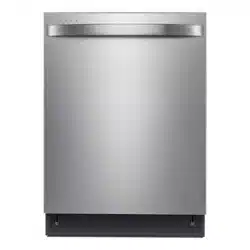Documents: Go to download!
User Manual
- User Manual - (English, French, Spanish)
- Specification - (English)
- installation instruction - (English)
- energy guide - (English)
- Service Manual - (English)
- OPERATING REQUIREMENTS
- PARTS AND FEATURES
- START UP GUIDE
- CONTROLS
- DISHWASHER LOADING
- DISHWASHER USE
- DISHWASHER CARE
- TROUBLESHOOTING
Table of contents
USER MANUAL Dishwasher
OPERATING REQUIREMENTS
ELECTRICAL REQUIREMENTS
WARNING: Electrical Shock Hazard
- Electrically ground dishwasher.
- Connect ground wire to green ground connector in terminal box.
- Do not use an extension cord.
- Failure to follow these instructions can result in death, fire, or electrical shock.
This dishwasher is designed for operation on an adequately wired individual 120 V, 60 Hz, 15- or 20-amp fused electrical supply with copper wire only. It is recommended that a time-delay fuse or circuit breaker is used, and that a separate circuit serving only this appliance is provided. If an outlet is used, the outlet should be placed in adjacent cabinet.
LOCATION REQUIREMENTS
- Install where dishwasher is protected from the elements. Protect against freezing to avoid possible rupture of fill valve. Such ruptures are not covered by the warranty. For winter storage information, see “Storing” in the “Dishwasher Care” section.
- Install and level dishwasher on a floor that will hold the weight and in an area suitable for its size and use.
WATER SUPPLY REQUIREMENTS
- The water supply temperature should be 120°F to 150°F (49°C to 66°C).
- The water supply must maintain water pressure between 20 and 80 psi for sufficient flow.
PARTS AND FEATURES
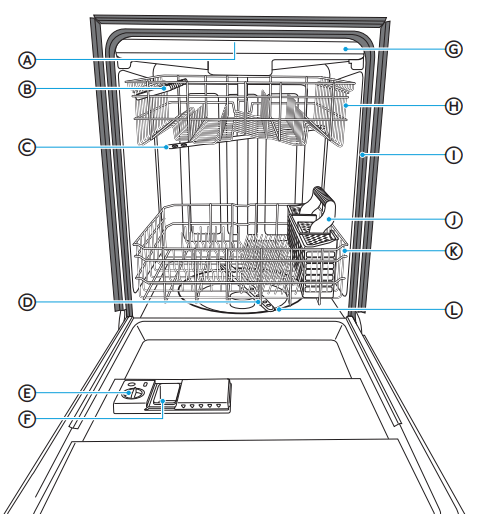
a Upper Spray Arm
b Cup Shelf
c Middle Spray Arm
d Lower Spray Arm
e Rinse Aid Dispenser
f Detergent Dispenser
g Third Rack
h Adjustable Upper Rack
i Tub Gasket
j Silverware Basket
k Lower Rack
l Heating Element
SPECIFICATIONS
- Capacity: 14 Place Settings
- Dimensions (WxDxH): 237/8" x 241/2" x 333/4" (606 x 623 x 857 mm)
- Weight Unpacked: 94 lb (42.5 kg)
- Power Supply: 120 volts, 60 Hz
- Rated Power Usage: Wash motor 50 W Heater 840 W
- Water Feed Pressure: 20 - 80 psi (138 - 552 kPA)
FILTER SYSTEM
- Your dishwasher has a multiple filter system, which helps your dishwasher perform better using less water and less energy.
- The filter system includes three filters that work in combination to separate dirty and clean water into different chambers.

SMART WASH SYSTEM
- Your dishwasher has a Smart Wash system which can be used by selecting the Auto cycle.
- The Smart Wash system senses the soil level of the load and adjusts the wash cycle accordingly. Your dishwasher can determine the type of cycle required to clean the dishes and will clean more efficiently every time.
ADJUSTABLE UPPER RACK
- The Adjustable Upper Rack feature allows you to load taller items in either the upper or lower rack.
- The upper rack of your dishwasher can be adjusted 2" (5.08 cm). Adjusting the clearance of the Upper Rack increases or decreases the clearance of the lower rack, as shown.
- For instructions, see the “Adjustable Upper Rack” section.
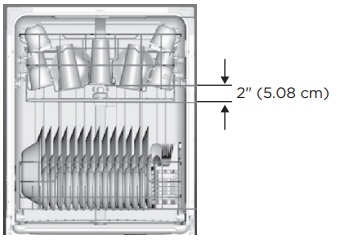
START UP GUIDE
IMPORTANT:
- Properly dispose of/recycle all packing material.
- Read this entire User Manual. You will find important safety information and useful operating tips.
HOW YOUR DISHWASHER CLEANS
- Your dishwasher cleans by spraying a mixture of hot water and detergent through the spray arms against soiled surfaces.
- The dishwasher fills with water covering the filter area. Water is then pumped through the multiple filters and spray arms. Soil particles are separated from the water and go down the drain as the water is pumped out and replaced with clean water.
- The number of water fills will vary depending on the cycle selected.
BEFORE USING YOUR DISHWASHER
- Check the filters for debris that may have been introduced from the packaging or during installation. See the “Clean Filters” section.
- Add Rinse Aid. See “Proper Use of Rinse Aid.”
USING YOUR NEW DISHWASHER
NOTE: To decrease cycle time and possibly improve performance, turn on the hot water faucet nearest to the dishwasher until the water runs hot. Turn off the water.
1. Load dishwasher. See “Dishwasher Loading.”
2. Add detergent. See “Proper Use of Detergent.”
3. Select desired CYCLE and OPTIONS. See “Cycle and Option Charts.”
- Only the Options available for the Cycle selected will illuminate.
- The controls of the selected Cycle and Options will glow to indicate they are selected.
4. Press START. IMPORTANT: For the dishwasher to begin operating, the door must be closed within 4 seconds after pressing Start/Cancel.
5. Close the door firmly to latch.
CONTROLS

NOTE: The dishwasher controls can be accessed and operated only when the dishwasher is open.
A- POWER
- Turn On - Press and hold POWER for 3 seconds
- Turn Off - Press and hold POWER for 3 seconds
B- CYCLES
- Press the control for the desired wash cycle. The control illuminates to indicate the cycle selected.
- AUTO: Auto cycle uses sensors in the dishwasher to determine the soil level of the dish load, and then adjusts the wash cycle to optimize wash performance, water and energy usage.
- HEAVY: Heavy cycle is for pots, pans, casseroles and dinnerware with dried-on or baked on soil.
- NORMAL: Normal cycle with only the Heat Dry option selected is recommended to completely wash and dry a full load of normally soiled dishes. The energy usage label is based on this cycle and option combination with the upper rack in the raised position.
- DELICATE: Delicate cycle is for items that need special care such as stemware or porcelain.
- QUICK: Quick cycle is for lightly soiled or well-rinsed dish loads.
- RINSE: Use for pre-rinsing dishes or glasses. This is only a rinse that keeps food from drying on your dishes and reduces odor buildup in your dishwasher until you are ready to wash a full load.
C- OPTIONS
Options enhance the wash cycle. Some Options are available with only certain Wash Cycles. Refer to the “Cycle and Options Charts” to see which Options are available for the wash cycle you selected. Press the desired Option control(s). The Option control(s) illuminates to indicate which option(s) have been selected.
- SANITIZE:
- WARNING: Only sanitizing cycles have been designed to meet the requirements for soil removal and sanitization efficacy. There is no intention, either directly or indirectly, that all cycles on a certified machine have passed the sanitization performance test.
- The sanitize option sanitizes dishes and glassware in accordance with NSF International NSF/ANSI Standard 184 for Residential Dishwashers. Certified residential dishwashers are not intended for use in licensed food establishments.
- When the Sanitize option is selected, the water temperature will reach 156.2°F (69°C) maximum.
- The Sanitize Control illuminates to indicate when the Wash cycle with the Sanitize option is completed. The light will turn off after the door has been opened for 30 seconds.
- NOTE: It is possible that the water will not reach 156°F (69°C) in the Sanitize mode, if the temperature of the incoming hot water does not meet the minimum requirement of 120°F (49°C).
- HI TEMP: When the Hi Temp option is selected, the water temperature will be maintained at 136°F (58°C) maximum during the wash portion of the cycle.
- HEATED DRY: When the Heated Dry option is selected, the heater will work during the drying process.
- EXTENDED DRY: When the Extended Dry option is selected, the heater and fan operation will be extended to further improve drying performance. The final rinse will be elevated to 156.2°F (69°C) and extend the Dry by 42 minutes.
D- ADDITIONAL FEATURES
DELAY
- The Delay Time feature allows you to program the dishwasher to begin the selected wash cycle 2, 4 or 8 hours later.
- Press the DELAY control repeatedly to toggle between (2h / 4h / 8h). The LED next to the selected time will illuminate.
- NOTE: To cancel the Delay feature, press and hold the START control for 3 seconds to Cancel. To begin the wash cycle immediately, press START again.
CTL LOCK (Control Lock): The Control Lock feature locks all controls to avoid unintentionally changing the dishwasher cycle or starting the dishwasher. The LED next to Control Lock will illuminate to indicate the Control panel is locked.
- Press and hold for 3 seconds DELICATE and QUICK at the same time to either activate or cancel the Control Lock option.
- Turning off Sound: Press and hold for 3 seconds AUTO and NORMAL at the same time to deactivate or activate the control tones and the end of cycle tone.
E - START
- START - Press START once and close the door. The cycle will begin. NOTE: You must close the door within 4 seconds of pressing START.
- PAUSE - If you need to pause or cancel a dishwasher cycle in process: IMPORTANT: Open the door slightly, and then wait for the spray arms and wash action to stop before opening the door completely. Doing this will help keep you from being splashed with hot water.
- Open the door slightly and wait a few seconds until the wash action stops.
- Open the door to add or remove items.
- Press START, and then close the door within 4 seconds.
- The wash cycle will automatically resume.
- CANCEL - To cancel a cycle when the dishwasher is running, open the door slowly. Press and hold START for 3 seconds and close the door.
F - INDICATOR LIGHTS
- Rinse Aid The Rinse Aid indicator light illuminates when the rinse aid level is low. Rinse Aid should be added to the Rinse Aid dispenser.
- Control Lock: The Control Lock indicator light illuminates to indicate the Control Panel is locked. Press and hold DELICATE and QUICK at the same time for 3 seconds to unlock the control panel.
- Sanitized: The Sanitized indicator light illuminates when the cycle using the Sanitize option is finished. The light turns off 30 seconds after the door is opened.
LED INDICATOR LIGHTS
Located on the front of the dishwasher is a row of four LED lights. These lights will either indicate the progress of the current cycle or alert you to a malfunction by indicating an Error Code.
CYCLE PROGRESS INDICATOR
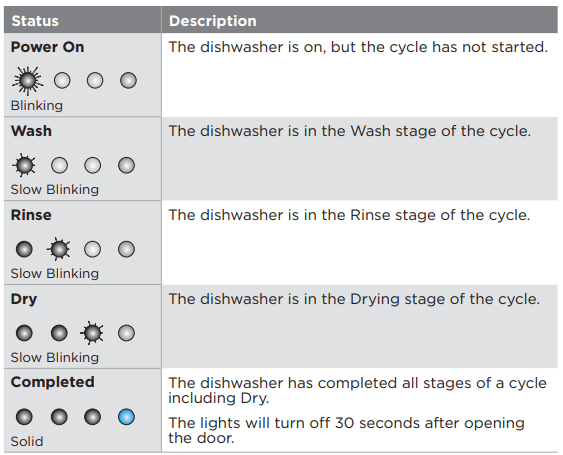
ERROR INDICATOR
- In situations, which are critical to dishwasher function and safe operation, the control will shut down and indicate an Error code in the display. See “Error Codes” in the Troubleshooting section. If an Error code is displayed, contact Midea Customer Service. They will be able to provide assistance with troubleshooting the problem or locating an authorized service technician.
CYCLE AND OPTION CHARTS
- Depending on the Cycle selected, the Options available for selection will illuminate.
- Cycle times are approximate and will vary depending on the wash cycle and options selected.
- NOTE: Added Options can add more time and use more water.
- Hot Water is necessary to activate the dishwasher detergent and melt fatty food residue.
- An automatic sensor checks the temperature of the incoming water. If the water is not hot enough, the cycle will be lengthened to heat the water for the main wash.
- When the HI-TEMP option is selected to wash heavily soiled loads, additional time to heat the water is required.
- The Smart Wash Sensor detects the soil level of the dish load and may increase or decrease cycle time depending on the number of water fills required to clean the load.
- A “•” shows what steps are included in each cycle. Temperatures indicate where extra heat is added. Water usage is shown in U.S. gallons/liters.
- The user should only be able to select either “Heated Dry” or “Extended Dry”, not both at the same time.
- “X”: shows it is available to be selected
- “O”: Can be selected, but cannot be selected if the other Dry option is selected
AUTO
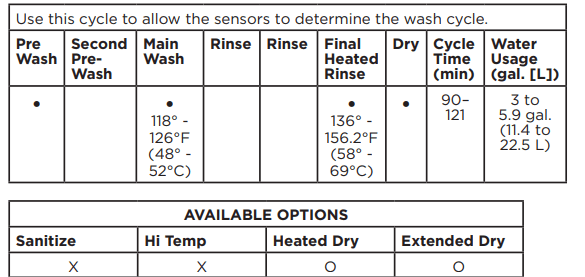
HEAVY
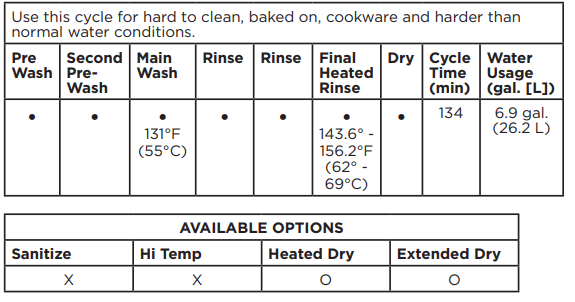
NORMAL
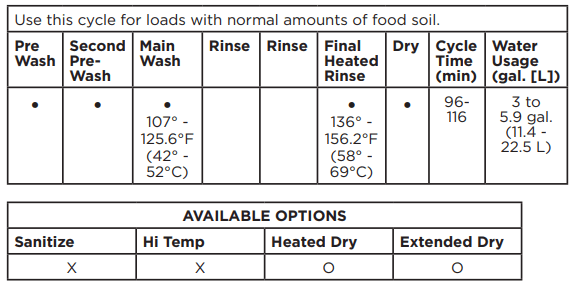
DELICATE
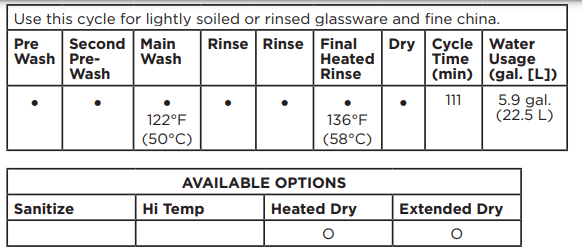
QUICK
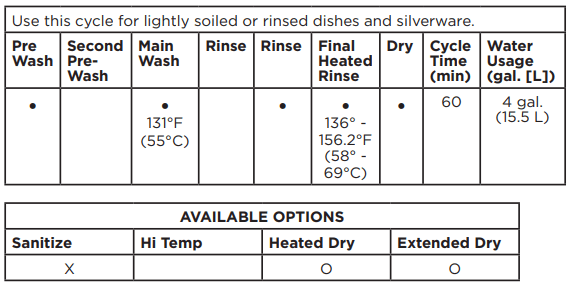
RINSE
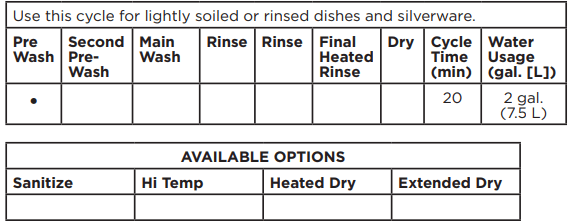
DISHWASHER LOADING
PREPARE DISHES: Empty liquids from glasses and cups.
- Remove leftover food, bones, toothpicks and other hard items from the dishes and discard.
- It is not necessary to hand-rinse dishes before loading them into the dishwasher with the following exceptions:
- Foods such as mayonnaise, mustard, vinegar, lemon juice and tomato-based products may discolor stainless steel and plastics if allowed to remain on them for any length of time.
- Burned-on foods should be loosened before loading the cookware into the dishwasher.
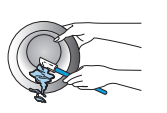
LOAD DISHES
- It is IMPORTANT for the water spray to reach all soiled surfaces.
- Load dishes so they are not stacked or overlapping if possible. For best drying results, water must be able to drain from all surfaces.
- Load heavy pots and pans carefully. Heavy items can dent the stainless steel interior of the door if they are dropped or bumped.
- Make sure pot lids and handles, pizza pans, cookie sheets, etc., do not interfere with the spray arm rotation.
- Make sure both the upper and lower spray arms are not blocked and move freely.
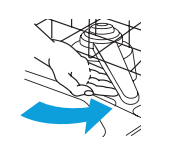
QUIET OPERATING TIPS: To avoid thumping/clattering noises during operation:
- Make sure lightweight items are secured in the racks.
- Make sure pot lids and handles, pizza pans, cookie sheets, etc., do not touch interior walls or interfere with the rotation of the spray arm.
- Load dishes so they do not touch one another.
NOTE: For built-in models, keep sink drain plugs closed during dishwasher operation to prevent noise transfer through drains.
UPPER RACK
The upper dishwasher rack is designed for cups, glasses, small plates, bowls and plastic items marked dishwasher safe.
The upper rack can be easily adjusted 2" (5 cm) up or down to accommodate taller items in either in the top or bottom rack
ADJUST UPPER RACK
IMPORTANT:
- Remove all items before adjusting the rack. The rack must be empty.
- Do NOT grasp adjustment arm when raising the upper rack. Grasping the adjustment arm will prevent the upper rack from engaging properly, and damage to dish ware could result if the upper rack releases.
To Raise the Upper Rack:
1. Grasp the uppermost wire on each side of the upper rack, and then lift up until each side clicks.

To Lower the Upper Rack:
1. Pull up on the adjustment arm located on each side of the upper rack.
2. Lower the upper rack until the rack is level in the lower position.
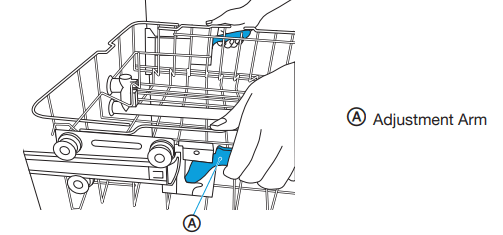
UPPER RACK SHELF: The upper rack has a shelf to accommodate short glasses, cups or cooking utensils such as spatulas.
To Engage the Shelf:
1. Lift straight up on the shelf.
2. Rotate the shelf to the center of the rack.
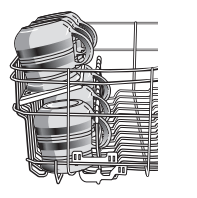
LOAD UPPER RACK
NOTE: The features on your dishwasher rack may vary from the drawings shown.
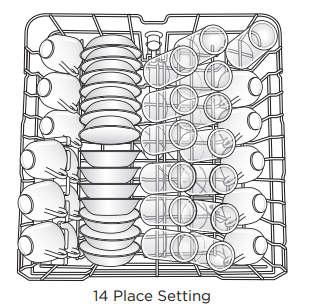
IMPORTANT: Make sure the items loaded in the upper rack do not interfere with the rotation of the middle spray arm located beneath the upper rack. Check for interference by turning spray arm by hand.
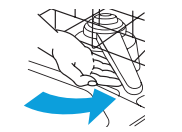
- Place items so that the open ends face downward for cleaning and draining.
- Load glasses and cups in upper rack only. The lower rack is not designed for glasses and cups. Damage can occur.
- Place cups and glasses in the rows between tines. Placing them over the tines can lead to breakage, water spots, and poor cleaning.
- Small bowls, pans and other utensils can be placed in the top rack. Load bowls in the center section for best stability.
- China, crystal and other delicate items must not touch each other during dishwasher operation. Damage may occur.
- Load plastic items so the force of the spray does not move them during the cycle.
LOWER RACK
- The lower rack is designed for plates, soup bowls, cookware and bakeware.
- The adjustable upper rack allows you to load items up to 13” in height in the lower rack.
- IMPORTANT: Items in the lower rack must be placed so that they do not interfere with the rotation of the spray arms, block the water inlet, or keep the water spray from reaching the detergent dispenser.

LOAD LOWER RACK - NOTE: The features on your dishwasher rack may vary from the drawings shown.
- Do not load glasses, cups, or plastic items in the lower rack.
- Load small items in the lower rack only if they are secured in place.
- Load plates, soup bowls, etc. between tines. Do not nest bowls because the spray will not reach all surfaces.
- Do not load items between the bottom rack and the side of the dishwasher tub.
- Place heavily soiled cookware face down in the rack.
- Load cookie sheets, cake pans, and other large items along the sides and back of the lower rack.
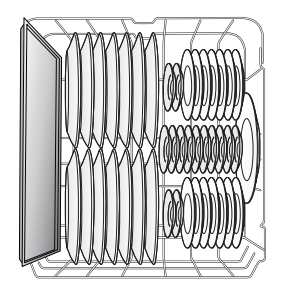
ADJUSTABLE RACK TINES
- The fold-down tines in the lower rack make it easier to load extra large or hard-to-fit items such as serving bowls and roasters. The tines may be left in the up position for normal use, or folded down for more flexible loading.
- To Lay Tines Down: Grasp the tip of the tine, gently pull the tine out of the tine holder and rotate the tine to the side.
- Upper Rack - Push the tines to the center of the rack.
- Lower Rack - Push the tines to the back of the rack.
- To Stand Tines Upright: Grasp and pull the tine until it is vertical and/or you feel it click into place. Verify the tines are secure before loading.
- Upper Rack - Push the tines to the right-hand side of the rack.
- Lower Rack - Pull the tines to the front of the rack.
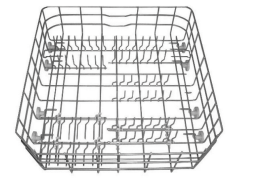
LOADING SILVERWARE
NOTES:
- Do not load silver or silver-plated silverware with stainless steel. These metals can be damaged by contact with each other during washing.
- Some foods (such as salt, vinegar, milk products, fruit juices, etc.), can pit or corrode silverware. DO NOT WASH ALUMINUM COOKWARE IN YOUR DISHWASHER.
THIRD RACK
- The Third Rack can be used to load cutlery or other accessories such as spatulas or cooking spoons.
- Silverware, knives, and utensils should be loaded in the Third Rack separate from each other in the appropriate positions so they do not nest together.
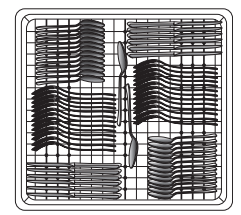
THREE-PIECE SILVERWARE BASKET: The silverware basket consists of three separate sections. For optimum loading flexibility, the center section of the basket can be used individually, joined with one or both side sections or removed.
- Lift handle to remove the silverware basket and set the basket on a counter or table top.
- Lift up on each side section to disengage the center section from the keyhole slots in the side sections.
- Either replace the section(s) in the bottom rack and load the silverware, OR load the silverware while the section(s) are on the countertop and then replace the basket in the bottom rack.

For Best Results:
- Load items with handles down, using the separators to prevent silverware from nesting.
- Place small items such as baby bottle caps, jar lids, corncob holders, etc. in the section(s) with hinged cover(s). Close the cover to hold small items in place.
- Unload or remove the basket before unloading the racks to avoid water drops from falling on the silverware.
- When handles are up, mix items in each section of the basket with some pointing up and some down to avoid nesting. Spray cannot reach nested items.

IMPORTANT: Always load sharp items (knives, skewers, etc.) pointing down. Be sure that nothing protrudes through bottom of the basket or rack that may block the wash arm.
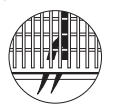
RECOMMENDED LOAD PATTERNS

NOTE: Remove the cutlery basket for additional space in the lower rack.
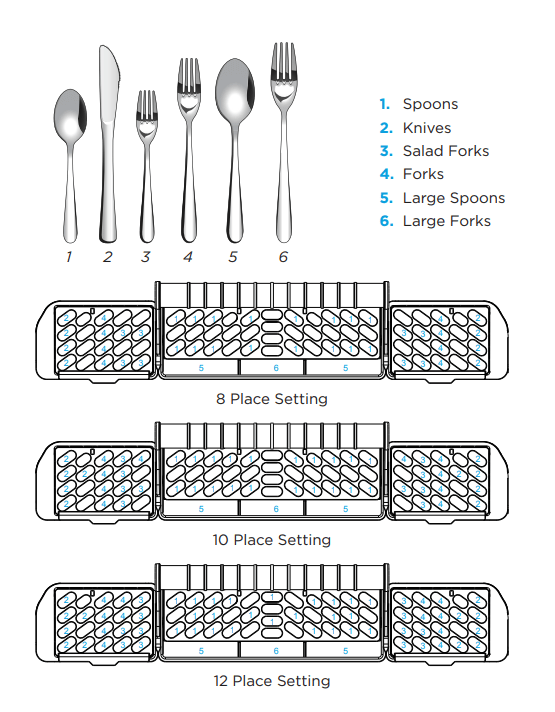
DISHWASHER USE
PROPER USE OF DETERGENT
IMPORTANT:
- Use automatic dish washing detergent only. Other detergents can produce excessive suds that can overflow out of the dishwasher and reduce washing performance.
- Add detergent just before starting a cycle.
- Store detergent tightly closed in a cool, dry place. Fresh automatic dishwasher detergent results in better cleaning.
DETERGENT DISPENSER
1. If the dispenser cover is closed, press in on the blue spring latch to release the cover. The cover will slide to the right.
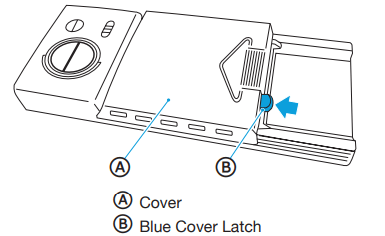
2. Add the recommended amount of detergent to the detergent cup. NOTE: If using dishwasher detergent in the tablet or pac form, place the detergent in the detergent cup, NOT in the tub to maximize the performance of the detergent.
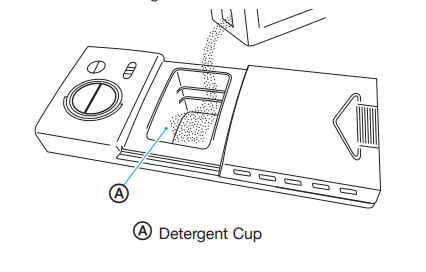
3. Slide the dispenser cover to the left, and then press down on the ridged arrow to close.

HOW MUCH DETERGENT TO USE:
- The amount of detergent to use depends on the soil level of your load, the type of detergent used and the hardness of your water.
- If you use too little detergent, dishes won’t be clean.
- If you have soft water and use too much detergent, glassware will etch.
- Water Hardness: Water hardness varies depending on your water source. For the best results, your dishwasher is designed to operate with water that has a hardness of no more than 7 grains per gallon. Test kits are available from all major appliance parts retail outlets. If your water has a hardness over 8 grains per gallon, you may consider installing a water softener or regularly use an additive to enhance the performance of your detergent.
PROPER USE OF RINSE AID
- Rinse aid prevents water from forming droplets that can dry as spots or streaks. A small amount of the rinse aid is released into the final rinse water, which allows water to drain from the dishes.
- Rinse aid greatly improves drying performance after the final rinse.
- Your dishwasher is designed to use a LIQUID rinse aid. Do not use a solid or bar-type rinse aid.
RINSE AID DISPENSER: Under normal conditions, you will need to fill the rinse aid dispenser approximately once a month. Rinse aid is released through an opening in the dispenser. You do not need to wait until the dispenser is empty to refill it. Try to keep it full, but be careful not to overfill it.
1. Open the dishwasher door.
2. Turn the rinse aid dispenser cap counterclockwise and pull up to remove.
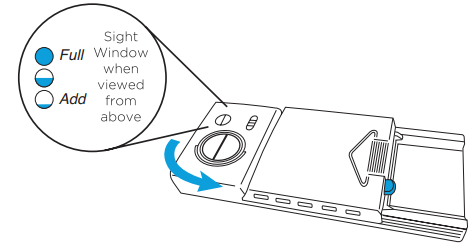
3. Pour rinse aid into the dispenser until the sight window indicates FULL.
4. You can adjust the amount of the rinse aid released during the rinse. The higher the number the greater the amount of rinse aid released.
- If your glassware has spots following the cycle, increase the rinse aid setting.
- If your glassware has streaks after the cycle, decrease the rinse aid setting
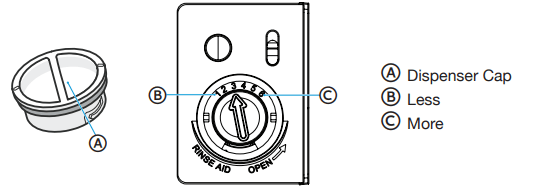
5. Clean up any spilled rinse aid with a damp cloth.
6. Replace the rinse aid cap, and then turn the cap clockwise to close.
WASHING SPECIAL ITEMS
If you have doubts about washing a particular item, check with the dishware manufacturer to make sure it is dishwasher safe.
Material - Dishwasher Safe - Comments
1. Aluminum
- Possible
- High water temperature and detergents can affect finish of anodized aluminum. Unfinished aluminum will be discolored.
2. Disposable Aluminum
- No
- Do not wash disposable aluminum pans in the dishwasher These might shift during washing and transfer black marks to dishes and other items.
3. Bottles and cans
- No
- Wash bottles and cans by hand. Labels attached with glue can loosen and clog the spray arms or pump and reduce washing performance.
4. Cast Iron No Seasoning will be removed and iron will rust.
5. China / Stoneware
- Yes
- Always check manufacturer’s recommendations before washing. Antique, hand-painted, or over-the-glaze patterns may fade, gold leaf can discolor or fade.
6. Crystal
- Yes
- Check manufacturer’s recommendations before washing. Some types of leaded crystal can etch with repeated washing.
7. Gold
- No
- Gold-colored flatware will discolor.
8. Glass
- Yes
- Milk glass yellows with repeated dishwasher washing.
9. HollowHandle Knives
- No
- Handles of some knives are attached to the blade with adhesive that can loosen if washed in the dishwasher.
10. Pewter Brass, Bronze
- No
- High water temperatures and detergent can discolor or pit the finish.
11. Disposable Plastics
- No
- Cannot withstand high water temperatures and detergents.
12. Plastics
- Yes
- Always check manufacturer’s recommendations before washing. Plastics vary in their capacity to withstand high temperatures and detergents. Load plastics in top rack only.
13. Stainless Steel
- Yes
- Run a rinse cycle if not washing immediately. Prolonged contact with food containing salt, vinegar, milk products, or fruit juice can damage finish.
14. Sterling Silver or Silver Plate
- Yes
- Run a rinse cycle if not washing immediately. Prolonged contact with food containing salt, acid, or sulfide (eggs, mayonnaise, and seafood) can damage finish
15. Tin
- No
- Can rust.
16. Wooden Ware
- No
- Wash by hand. Always check manufacturer’s instructions before washing. Untreated wood can warp, crack, or lose its finish.
DISHWASHER CARE
CLEANING
CLEANING THE EXTERIOR
- In most cases, regular use of a soft, damp cloth or sponge and a mild detergent is all that is necessary to clean outside of your dishwasher.
- Clean the stainless steel door and handle regularly with a clean, soft cloth to remove debris. I
- MPORTANT: Do not use appliance wax, polish, bleach, or products containing chlorine to clean the stainless steel door.
- Control Panel: Gently clean the control panel with a clean, soft cloth.
CLEANING THE INTERIOR
- The tub is made of stainless steel designed to resist rust and corrosion if the dishwasher is scratched or dented.
- Hard water minerals can cause a white film to build up on the inside surfaces, especially just beneath the door area.
- Do not clean the dishwasher interior until it has cooled. Wear rubber gloves. Do not use any type of cleanser other than dishwasher detergent because it may cause foaming or create suds.
DOOR GASKET
- Clean the steel inner door and tub with a clean, soft damp cloth.
- Using a damp cloth, clean around the door gasket regularly to remove food particles.
CONTROL PANEL
- Clean the Control Panel gently with a lightly dampened cloth.
CLEANING THE FILTERS: Check and clean the filters regularly for best performance
1. Remove the lower dishwasher rack.
2. Rotate the Cylinder filter counterclockwise a quarter turn and lift up to remove
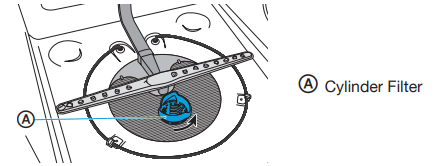
3. Empty the Cylinder filter and rinse it under running water.
4. Remove the Fine filter.

5. Remove the Micro filter from the bottom of the tub.
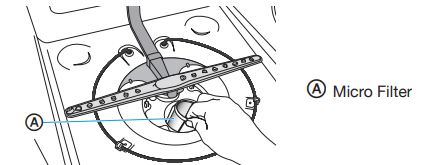
6. Inspect both the Fine filter and the Micro filter for debris, and then clean them by holding the filters under slow running water. NOTE: A stiff, plastic bristle brush may be needed to remove some debris.
7. Reinstall the filters in reverse order making sure the Cylinder filter locks into place.
DRAIN AIR GAP
- Check the drain air gap anytime your dishwasher isn’t draining well. Some state or local plumbing codes require the addition of a drain air gap between a built-in dishwasher and the home drain system. If a drain is clogged, a drain air gap prevents water from backing up into the dishwasher.
- The drain air gap is usually located on top of the sink or countertop near the dishwasher.
- NOTE: The drain air gap is an external plumbing device that is not part of your dishwasher. The warranty provided with your dishwasher does not cover service costs directly associated with the cleaning or repair of the external drain air gap.
- To Clean the Drain Air Gap: Clean the drain air gap periodically to ensure proper drainage of your dishwasher. Follow the cleaning instructions provided by the manufacturer.
- With most types:
- Turn off the dishwasher.
- Lift off the metal cover, and then unscrew the plastic cap.
- Clean the plastic cap with a toothpick.
STORING
STORING FOR THE SUMMER: Protect your dishwasher during the summer months by turning off the water supply and power supply to the dishwasher.
WINTERIZING YOUR DISHWASHER: Protect your dishwasher and home against water damage caused by freezing water lines. If your dishwasher is left in a seasonal dwelling or could be exposed to near freezing temperatures, have your dishwasher winterized by authorized service personnel.
Prepare for Storage:
- Turn off electrical power to the dishwasher.
- Turn off the water supply.
- Place a pan under the inlet valve, and then disconnect the water line from the inlet valve.
- Disconnect the drain line from the pump and drain water into the pan.
Prepare for Use:
- Reconnect the water, drain and electrical power supply.
- Turn on water and electrical power supply.
- Fill detergent cup and run the dishwasher through a heated wash cycle.
- Check the connections for leaks.
TROUBLESHOOTING
DISHWASHER NOT OPERATING PROPERLY
1. Dishwasher does not run or stops during a cycle
- There is no power to the dishwasher.
- Replace fuse or reset circuit breaker.
- The door is not closed tightly and latched.
- Close and latch the door.
- Most cycles pause for 5 minutes near the start of a cycle to let the dishes soak.
- This is normal, and reduces the energy required to clean the dishes.
- Certain cycles repeatedly pause for 15 to 65 seconds during the main wash.
- This is normal.
- The Delay feature is selected.
- To reset, see “Options” in the Controls section.
2. Dishwasher does not start a cycle
- Control
- Lock feature is activated.
- Door not closed within 4 seconds of START button being pressed
- Deactivate Control Lock. See “Additional Features” in the Controls section. Close door within 4 seconds of pressing START.
3. Dishwasher will not fill
- The water shutoff valve is not turned on.
- Turn on the water valve.
- The door is not closed tightly and latched.
- Close and latch the door.
- Water pressure is too low.
- Verify a minimum of 20 psi water pressure is maintained during the filling operation.
4. Dishwasher seems to run too long
- The water supplied to the dishwasher is not hot enough.
- The dishwasher runs longer while heating water, and a delay automatically occurs in some wash and rinse cycles until the water reaches the proper temperature.
- Run the water in the adjacent sink until it gets hot before turning on the dishwasher.
- The Sanitize option is selected.
- The cycle time increases to heat the water to the correct temperature for sanitizing.
- The cycle time will vary depending on soil level.
- When heavy soil is detected, the Normal cycle will automatically increase the cycle time.
- Dishwasher is connected to the Cold water supply.
- Verify the dishwasher is connected correctly to the Hot water supply.
5. Water remains in the dishwasher. NOTE: A small amount of clean water around the outlet in the bottom of the tub is normal. It keeps the seal lubricated.
- The cycle is not complete or it is in a pause.
- The water will drain when the cycle is completed.
- The drain hose is kinked.
- Straighten the drain hose.
- The knockout plug is still in the garbage disposal.
- Remove the knockout plug.
- Drain hose is connected to the garbage disposal, and the garbage disposal is not empty.
- Run the garbage disposal until it is empty.
- Drain is clogged.
- Check the air gap.
6. Detergent remains in the dispenser
- The cycle has not completed.
- Close the door and press START to complete cycle.
- The detergent is damp or has clumped.
- Remove detergent and replace with fresh dry dishwasher detergent.
- An item was blocking the dispenser.
- Remove item. Remove detergent and replace with fresh dry dishwasher detergent.
- The spray arm is blocked.
- Load the dishes in a manner that does not block the spray arm from rotating freely
7. Grinding, grating, crunching or buzzing sounds
- A hard object or powder detergent granules have entered the wash module.
- IMPORTANT: Clear glass is hard to see in water. and could result in a cut wound.
- Using care, remove the hard object. If the noise was caused by detergent granules, the noise should stop once the detergent is ground up.
- NOTE: If the noise persists after a complete cycle, call for service.
8. Beeps
- Indicates the wash cycle is completed.
- This is normal.
- NOTE: A rapid beep indicates an error condition.
- See “Error Codes” for further direction.
9. Suds in the Tub
- Used wrong type of detergent.
- Use only detergent approved for automatic dishwashers.
10. Dishwasher Leaks
- Excessive suds caused by using improper detergent.
- Use only detergent approved for automatic dishwashers.
- Dishwasher is not level.
- Level the Dishwasher. See Installation Instructions.
11. Rinse Aid light is on
- The Rinse Aid level is low.
- Add liquid Rinse Aid
DISHES ARE NOT COMPLETELY CLEAN
1. Food residue remains on the dishes
- Dishwasher is not loaded correctly.
- See “Dishwasher Loading.”
- The wrong wash cycle for the dish load was selected.
- Select the wash cycle based on the most difficult soil in the dishwasher load. If you have some items with heavier soils, use a heavier washing cycle.
- Water temperature is too low.
- For best results, the temperature of the incoming water should be a minimum of 120°F (49°C).
- Used incorrect amount of detergent.
- Use a minimum of 1 Tbsp. (15 g) detergent per load. Heavy soil and/or hard water generally requires additional detergent.
- Detergent is too old.
- Detergent must be fresh to be effective. Store detergent in a cool, dry area.
- Detergent is caked in the dispenser.
- Do not allow detergent to sit for several hours in a wet dispenser. Clean dispenser and refill with fresh, dry detergent.
- The pump or spray arm is clogged with labels from bottles and cans.
- Check pump and spray arm for labels and remove the labels.
- The pressure of the water coming into the home is too low.
- Water pressure should be 20 to 80 psi (138 to 552 kPa) for proper dishwasher fill. A booster pump on the water supply can be added if pressure is too low.
- High suds are slowing the wash arm.
- Use only detergent recommended for the dishwasher. Do not use soap or laundry detergents.
SPOTS AND STAINS ON DISHES
1. Spotting and filming on dishes
- Rinse Aid dispenser is empty.
- Add a liquid rinse aid to the dispenser.
- Hard water. High mineral content in your water
- Use a rinse aid and keep the dispenser filled to help eliminate spotting and filming. Increase setting on Rinse aid dispenser 1 number per cycle until spotting is eliminated.
- NOTE: If your water hardness is 13 grains (223 ppm) or above, it is strongly recommended that you install a home water softener.
- Water temperature is too low.
- For best results, water should be a minimum 120°F (49°C) as it enters the dishwasher.
- Did not use enough detergent.
- Use a minimum of 1 Tbsp. (15 g) of detergent per load. Heavy soil and/or hard water generally require extra detergent.
- Detergent is too old.
- Detergent must be fresh and dry to be effective. Store detergent in a cool, dry area.
- Home water pressure is too low to fill dishwasher properly.
- Water pressure to the home should be 20 to 80 psi (138 to 552 kPa) for proper dishwasher fill. A booster pump on the water supply can be added if pressure is too low.
2. Silica film or etching
- Using too much detergent
- If you have soft water use less detergent, but do not use less than 1 Tbsp. (15 g) per load.
- The inlet water temperature exceeds 150°F (65°”C).
- Lower the incoming water temperature.
3. Black or gray marks on dishes
- Aluminum items rubbing dishes during washing. Disposable aluminum items can break down in the dishwasher and cause marking.
- Hand wash aluminum items. Remove aluminum markings by using a mild abrasive cleaner.
4. Orange stains on plastic dishes or dishwasher interior
- Large amounts of tomato-based foods on dishes placed in the dishwasher.
- Use a stain removal product to remove stains from your dishwasher. Stains will not affect dishwasher performance.
DISHES DO NOT DRY COMPLETELY
1. Dishes are not completely dry NOTE: Plastics often need towel drying.
- Dishes are not loaded properly to allow water drainage.
- Do not overload dishwasher. Place glasses and cups in the rack so that the bottom surface is slanted to allow water to run off.
- Rinse Aid not used or dispenser is empty.
- Use a liquid rinse aid to speed drying and keep the dispenser full.
- Used an air dry or energy-saving option.
- For dryer dishes, select a Cycle that allows a Heated Dry option.
DISHES ARE DAMAGED DURING A CYCLE
1. Dishes are chipped - NOTE: Some types of china and glassware might be too delicate for automatic dish washing. Wash by hand.
- Dishes not loaded properly.
- Load the dishes and glasses so they are stable and will not strike together from washing action.
- Moving the rack in or out of the dishwasher too quickly.
- Minimize chipping by moving the rack in and out slowly.
ERROR CODES
1.  Code E1: Not enough water flow in allotted time
Code E1: Not enough water flow in allotted time
- Low or No water flow.
- Confirm water is turned on to the dishwasher. Verify water pressure. NOTE: Water supply must maintain water pressure between 20 and 80 psi for sufficient flow.
2.  Code E4: Overflow or leak sensor activated
Code E4: Overflow or leak sensor activated
- Too much water in the tub or a leak.
- First, turn off water to the dishwasher. Check filter system for blockage. IMPORTANT: Watch for broken glass in the filter. If there is no water in the tub, contact Customer Service.
3.  Code Ed: Communication exception
Code Ed: Communication exception
- When the display board can’t receive or the main board can’t send signal over 20 seconds, the dishwasher will warning for Ed.
- Contact Customer Service.
See other models: WHS-169WES1 MTA10CR82-E MWA06CR71-E WHD-774FSSE1 MFWS512
